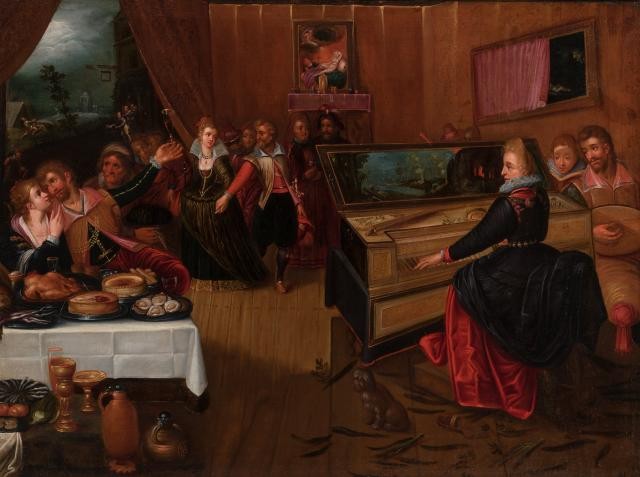Allegories from Antwerp
05/20/2020 Old Master Paintings

NEW YORK, NY -- Antwerp was the most important commercial center in Northern Europe in the mid-16th century. The city received merchandise from all of continental Europe and its ships carried those goods throughout the world. According to the Florentine merchant Lodovico Guicciardini, who lived in Antwerp from the early 1540s until his death in 1589 and published a widely-read description of the Low Countries, the city’s people were not only wealthy but “...humane, civilized, ingenious ... [with] much worldly good sense.” He noted that a large percentage of them, in addition to being prosperous, were well-educated and spoke three or four languages. Not surprisingly, then, Antwerp was also a significant center of humanistic learning. The city boasted excellent schools, important publishing houses and, not incidentally, thriving painting studios.
Hieronymus Francken the Elder
Hieronymus Francken the Elder (1540-1610), one of a family of artists, trained in his father’s studio in Antwerp before moving in the mid-1560s to France, where he spent most of his career. Even while living in Paris, however, he felt the need to return repeatedly to Antwerp throughout his life to refresh family and professional ties. While in France he worked for a number of noble and royal patrons, painting portraits, biblical and mythological subjects as well as scenes of elegant ladies and gentlemen feasting and dancing.
A characteristic example of this last type is his Banquet Scene: An Allegory of Love and Carnality probably painted during the 1590s. Here we consider a dissolute young man seated in the left foreground, before a table laid with oysters, meat pies, roast chicken, fruit, and wine. As he indulges in this sumptuous array, he embraces an amorous lady, while an older woman, apparently her procuress, hovers over them.
In contrast to this group, at the center of the room a genteel couple is shown dancing ceremoniously to the music of a lute and a clavichord. Hanging on the walls are love scenes from Classical mythology, a visual gloss that makes it clear that the subject of the painting is love. The meaning of this work is more pointedly brought home by two small vignettes visible through a large opening at the back of the room. There in the far distance we can see a young man—presumably the young man at the table—in two separate moments in the future, first being roughly thrust from the door of a tavern and later kneeling in the mud of a pigsty. These scenes are a clear reference to the parable of the Prodigal Son (Luke 15: 12-16), who squandered his inheritance in wild living and was reduced to tending swine, so hungry that he envies their coarse food. The painting is thus a moralizing allegory of the value of genuinely committed love—exemplified by the couple moving decorously to the harmonies of chamber music—and the folly of unrestrained carnality.
Hendrick van Balen the Younger and Jan Brueghel the Younger
Not all allegories produced in Antwerp were intended for moral instruction, however. Other favorite subjects were the Liberal Arts, the Five Senses, the Months, and the Seasons, which, despite their underpinnings of humanist learning, were essentially decorative. An example of this type is Persephone: An Allegory of Spring, dating to the first half of the 17th century and attributed to the Antwerp painters Hendrick van Balen the Younger (1623-1661) and Jan Brueghel the Younger (1601-1678). Here Persephone, the Greek goddess of spring, is newly returned from her winter home in the Underworld and seated next to her mother, Demeter, the goddess of agriculture and plant life. As Queen of the Underworld Persephone wears a diadem of pearls, while Demeter is shown holding bouquets of flowers. Behind the goddesses, two attendants carry an armillary sphere—a reference to the turn of the seasons—and a torch, Demeter’s standard attribute, an emblem of her long search for Persephone after she was abducted by Hades.
Around the goddesses the earth teems with living creatures—fish, birds, land animals of every sort—as well as fruit and vegetables, as if bursting with joy at Persephone’s return. In the distance at the left a procession of sea gods makes its way along a broad waterway toward the seated pair, as if to welcome Persephone home. Meanwhile, in the distance on the right, in the mouth of a cave in a mountainside, we can make out a group of blacksmiths at a forge, a reminder that the ores they work with are mined from the Underworld to which Persephone must return in the autumn.
Flemish artists in the 17th century tended to specialize. Some were landscape painters, others were figure painters, still others were dedicated to depicting animals or still lifes. Collaborations among these professionals were common. In this painting Jan Brueghel the Younger is thought to have provided the landscape, including the flowers, fish, birds, and animals, while Hendrick van Balen the Younger is thought to have added the goddesses and their attendants. The meticulous description of all these elements, the intensely colored palette, and the mythological subject, which required a level of education to appreciate, suited the taste of Antwerp’s wealthy and sophisticated collectors perfectly.
Old Master Paintings
The auction on June 3, 2020 offers two fascinating allegorical paintings, one by Hieronymus Francken the Elder and the other attributed to Hendrick van Balen the Younger and Jan Brueghel the Younger.